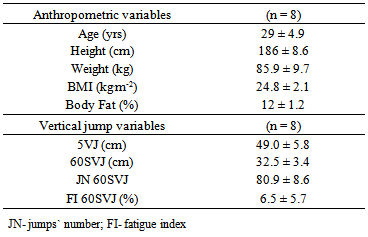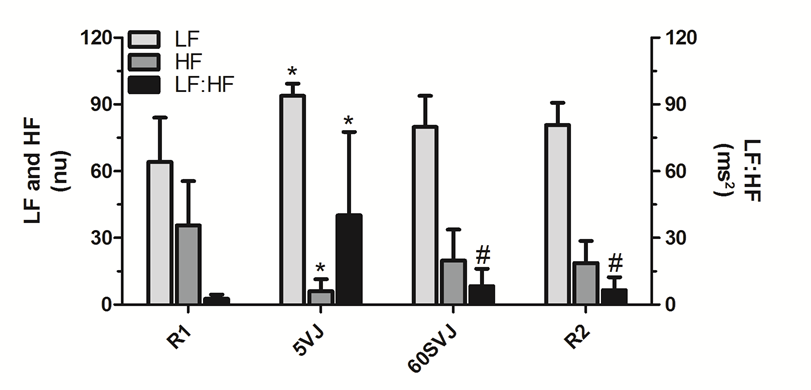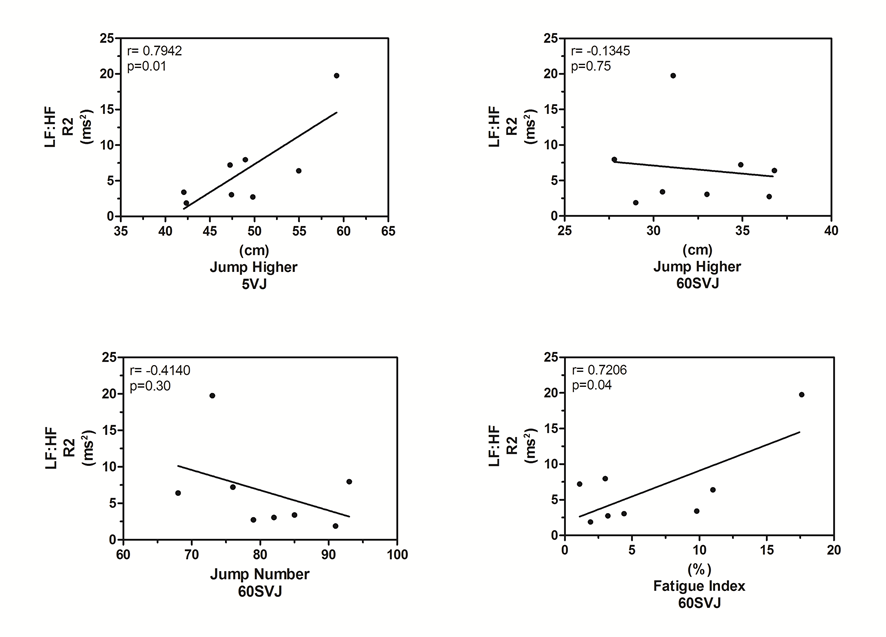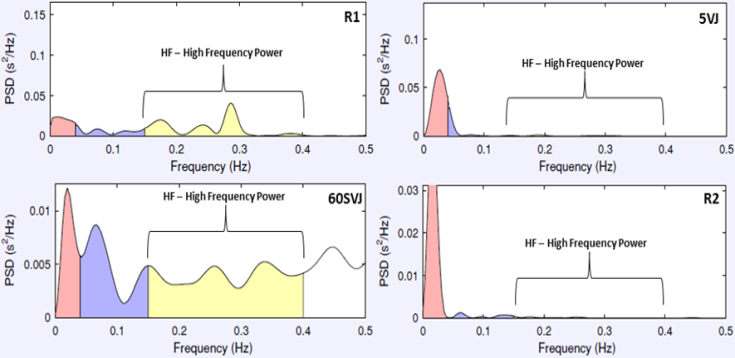-
Paper Information
- Previous Paper
- Paper Submission
-
Journal Information
- About This Journal
- Editorial Board
- Current Issue
- Archive
- Author Guidelines
- Contact Us
International Journal of Sports Science
p-ISSN: 2169-8759 e-ISSN: 2169-8791
2014; 4(2): 72-78
doi:10.5923/j.sports.20140402.06
Heart Rate Variability Responses in Vertical Jump Performance of Basketball Players
Anderson Pontes Morales1, 2, 3, Felipe Sampaio-Jorge1, 2, 3, Luiz Felipe da Cruz Rangel1, 2, Gabriela Morgado de Oliveira Coe1, Tiago Costa Leite1, Beatriz Gonçalves Ribeiro1
1Laboratory Research and Innovation in Sports Sciences, Federal University of Rio de Janeiro-Macaé Campus, Macaé, 27930-560, Brazil
2Sports and Tourism of Foundation of Macaé, The Municipality of Macaé, Macaé, 27937-180, Brazil
3Laboratory of Movement Analysis ISECENSA, Higher Institutes of Education of Censa, Campos dos Goytacazes, 28035-310, Brazil
Correspondence to: Anderson Pontes Morales, Laboratory Research and Innovation in Sports Sciences, Federal University of Rio de Janeiro-Macaé Campus, Macaé, 27930-560, Brazil.
| Email: |  |
Copyright © 2014 Scientific & Academic Publishing. All Rights Reserved.
Our objectives were to investigate the acute responses of the heart rate variability (HRV) before, during and after the execution of different Vertical Jump (VJ) protocols and correlate the levels of sympathetic and parasympathetic modulation after the VJ execution with the performance variables in VJ. Eight male athletes (29±4.9 years; 186±8.6 cm; 24.8±2.1 kg.m-2; 12±1.2% body fat) of a team participating in the first division of the National Basketball League (NBL), from Brazil, were evaluated. For the HRV analysis, each subject was instructed to stand in a orthostatic position on the jump platform System Optical (Cefise®, São Paulo) for a period of 10 minutes of rest before (R1) and after the VJ executions (R2). Right after the R1 period, athletes performed 5VJ with five seconds intervals (total time ~ 30 seconds) between VJ (5VJ) and then underwent 60 seconds of maximum continuous VJ (60SVJ). The HRV were automatically transferred and analyzed by the softwares “Polar ProTrainer5™” (version 5.41.002., Kempele, Finland) and HRV analisys (version 2.1., Kuopio, Finland), respectively. The HFnu was used to represent the parasympathetic modulation, whereas LFnu represented the sympathetic modulation. The ratio LF:HF was used to represent the balance between sympathetic and parasympathetic modulations. The one-way Analysis of Variance (ANOVA) with post hoc Tukey test was used to compare differences in HRV during the execution of the experimental protocol. Linear regression and Pearson's correlation coefficient were used between the VJ performance variables (mean of 5VJ and 60SVJ, jumps` number and fatigue index) and the sympathetic and parasympathetic modulation LF:HF R2 (p< 0.05). The following comparisons of the HRV were found between the different protocols: 5VJ (LF 93.9±5.4 nu) versus R1 (LF 64.2±19.9 nu); 5VJ (HF 6.0±5,4 nu) versus R1 (HF 35.6±19,9 nu); 5VJ (LF:HF 40.1±37.4) versus R1 (LF:HF 2.6±1.9 nu) (p < 0.001); 60SVJ (LF:HF 8.3±13.8 ms²) versus 5VJ (LF:HF 40.1±7.7 ms²); R2 (LF:HF 6.5±5.7 ms²) versus 5VJ (LF:HF 40.1±7.7 ms²) (p < 0.001). A significant correlation was found between the average height of 5VJ with the sympathetic and parasympathetic modulation LF:HF R2 (r = 0.7942 , p = 0.01 ) and fatigue index 60SVJ with the sympathetic and parasympathetic modulation LF:HF R2 (r = 0.7206 , p = 0.04). It is concluded that the 5VJ test characterized by intermittent high intensity loads, showed high significant responses of sympathetic modulation (LF; LF:HF) compared to the 60SVJ protocol. The 5 min recovery was not sufficient for the onset of vagal tone (parasympathetic modulation), which was accompanied by higher fatigue index presented by basketball athletes.
Keywords: Heart Rate Variability, Vertical Jump, Basketball
Cite this paper: Anderson Pontes Morales, Felipe Sampaio-Jorge, Luiz Felipe da Cruz Rangel, Gabriela Morgado de Oliveira Coe, Tiago Costa Leite, Beatriz Gonçalves Ribeiro, Heart Rate Variability Responses in Vertical Jump Performance of Basketball Players, International Journal of Sports Science, Vol. 4 No. 2, 2014, pp. 72-78. doi: 10.5923/j.sports.20140402.06.
Article Outline
1. Introduction
- The Vertical Jump (VJ) is one of the most common actions performed by basketball players. For example McInnes et al [26] found that, on average, a basketball player performs 46 VJ per game. Authors like Ben Abdelkrim; El Fazaa and El Ati [2] reported an average of 44 VJ. The physiological demands during a basketball game are characterized by production of repetitive force levels [24]. Thus, it becomes possible for the athlete to execute a greater number of VJ repetitions in offensive and defensive action a specific period of execution, without the implementation of fatigue processes and also be able to recover quickly after, and during continuous and intermittent high-intensity efforts [38]. Therefore, one of the basketball players’ aim during the game is to improve their ability to perform a greater number of VJ with a lower level of muscle fatigue [39].It is suggested that muscle fatigue blocks the increase in VJ performance [35, 29]. The monitoring of the Autonomic Nervous System (ANS) responses can provide useful information about acute or chronic changes in training status [3]. It has been observed that the ANS is sensitive to changes in training loads [25, 18] and it seems to be an important variable for the individualized training prescription [21]. Furthermore, the ANS analysis in the period prior to a training program had a positive relationship with increased cardiorespiratory capacity after training, in non-athletes [16], suggesting that the assessment of the ANS may be an important "tool" to predict the onset of muscle fatigue during the execution of successive VJ.At rest and at intervals of VJ executions, the heart's activity is regulated primarily by parasympathetic vagal branch of the ANS. During the execution of VJ intermittent high-intensity exercises, an increase in heart rate and stroke volume is required to meet the metabolic demands of skeletal muscles, thus, a response is triggered by ANS with a vagal withdrawal followed by sympathetic dominance [14]. Immediately after the workout session or during continuous VJ exercises, there is a vagal activity return [19, 12, 7]. Within this perspective, individuals with a predominant vagal activity may display a higher level of tolerance to muscle fatigue [13, 10]. The evaluation of the heart rate variability (HRV) describes the changes of HR, through the analysis of R R intervals, demonstrated by electrocardiogram tracing, which is used to measure the ANS function of the ANS. This "tool" has been shown to predict the physical shape, helping to evaluate the results of physical training [19, 3, 17]. However, most research in this area is traditionally focused on clinical situations due to its relationship with cardiovascular disease [34, 8, 9, 36, 33]. Studies that investigate the acute responses of HRV in the VJ performance, where the sport involves contributions from intermittent and continuous activities such as basketball, have not been fully explored. Given this background, the objectives of this research are: to investigate the acute responses of the autonomic activity indices before, during and after the execution of different VJ protocols; to correlate the levels of sympathetic and parasympathetic modulation after the VJ execution with the performance variables in VJ.
2. Methods
2.1. Subjects
- Eight male athletes of a team participating in the first division of the National Basketball League (NBL), from Brazil, were evaluated. Descriptive statistics are presented in Table 1. All participants volunteered for this study, which was approved by the Committee for Research Ethics Concerning Human Subjects, by the local university. Data were collected during two visits to the laboratory. The subjects presented themselves healthy, free of cardiopulmonary, metabolic, and orthopedic diseases. Furthermore, they did not use medications frequently. Prior to visiting the laboratory, subjects were instructed not to consume alcoholic beverages or sympathomimetic drugs for 12 hours before testing.In the first visit to the lab, the athletes` height and body mass were measured (to the nearest 0.1 cm) by a wall stadiometer (SECA) and a digital scale (to the nearest 0.1 kg) (TANITA UM-061). The Body Mass Index (BMI) was calculated using the data of body weight divided by height squared (kg.m-2). The percentage body fat (BF) was estimated by the seven point skin fold method, described by established guidelines [1].
2.2. Procedures
2.2.1. Heart Rate Variability
- For the HRV analysis, each subject was instructed to stand in a orthostatic position on the jump platform for a period of 10 minutes of rest before (R1) and after the VJ executions (R2). Right after the R1 period, athletes performed 5 VJ with five seconds intervals (total time ~ 30 seconds) between VJ (5VJ) and then underwent 60 seconds of maximum continuous VJ (60SVJ). The HRV analyses were performed between R1 and R2 in the last 5 minutes, during 5VJ and 60SVJ protocols. HRV was monitored continuously during the experimental protocol, except in the interval between 5VJ and 60SVJ (interval, 2 seconds) (Figure1). The analyses followed the guidelines for the HRV assessment [37]. The HRV were automatically transferred and analyzed by the softwares “Polar ProTrainer5™” (version 5.41.002., Kempele, Finland) and HRV analisys (version 2.1., Kuopio, Finland), respectively. The power spectral density was quantified using the Fast Fourier Transform (FFT). The frequency bands of high HFnu (0.15-0.40 Hz) and low LFnu (0.04-0.15 Hz) spectrum were normalized (nu) and recorded, respectively. The ratio between the low and the high frequency rate (LF:HF) was recorded in absolute units (ms²) and included in the data analysis. The HFnu was used to represent the parasympathetic modulation, whereas LFnu represented the sympathetic modulation. The ratio LF:HF was used to represent the balance between sympathetic and parasympathetic modulations [37].
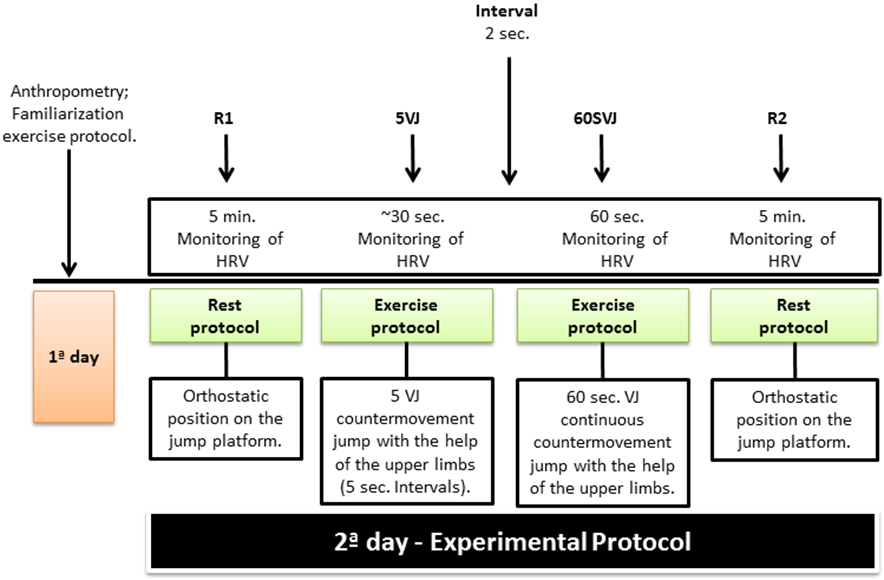 | Figure 1. Experimental design. R1 - Rest before the exercise protocol; 5VJ - Five vertical jumps; 60SVJ - 60 seconds vertical jumps; R2 - Rest after the exercise protocol |
2.2.2. Vertical Jump Performance
- The VJ performance was evaluated by the jump platform System Optical (Cefise®, São Paulo). This equipament consists of a laptop with the software "Jump System" (version 1.0, São Paulo, Brazil), connected by a cable to a resistive (or capacitative) platform (equipped with infrared optical sensors). The timer software is triggered by the feet of the subject at the moment of release from the platform, and will be stopped at the moment of touch down. This equipment has the same principle of “Ergojump” [4] to inform the flight time (ms) and contact (ms). The error of measurement, when compared with film analysis has been reported to be in the order of ± 2% [22]. Athletes performed the countermovement jump technique in both protocols (5VJ and 60SVJ). The athlete was positioned, barefoot, in the interior of platform and the jumps were performed starting from a standing position until approximately at an angle of 90° knee, using help from upper limbs at the time of the VJ execution. All participants were familiarized with these procedures on the 1st visit to the lab. In 5VJ, the average height of the 5 VJ was used. In 60SVJ, we used the average height, the jumps’ number (JN) and the fatigue index (FI) of the VJ performed during 60 seconds. The FI was calculated by the following adapted equation, described by Bosco; Luhtanen and Komi [5]:FI % = (VJ 45-60sec. / VJ 0-15sec.) x (100) - 100In which VJ 45-60sec.(cm) is the average height of the VJ performed during the last 15 seconds of effort in the 60SVJ test; VJ 0-15sec.(cm) is the average height of the VJ performed during the first 15 seconds of effort in the 60SVJ test.
2.3. Statistical Analyses
- Data were entered in SPSS 16.0 software for statistical analysis. Descriptive statistics (mean ± SD) was determined for the following variables: age (years), height (cm), weight (kg), BMI (kg m-2), percentage body fat (%), mean of 5VJ (cm) and 60SVJ, jumps’ number and fatigue index (%). The Shapiro-Wilk test was used to verify data normality. The one-way Analysis of Variance (ANOVA) with post hoc Tukey test was used to compare differences in autonomic activity during the execution of the experimental protocol. Linear regression and Pearson's correlation coefficient were used between the VJ performance variables (mean of 5VJ and 60SVJ, jumps’ number and fatigue index) and the sympathetic and parasympathetic modulation LF:HF R2. Statistical significance for all tests was set at p< 0.05.
3. Results
- Table 1 represents the descriptive statistics of anthropometric and VJ values.
|
4. Discussion
- The main interest of assessing levels of HRV is related to the prognosis of cardiovascular diseases [9, 36, 33]. However, the literature is expanding these assessments to the contexts related to the generation of muscle strength and cardiorespiratory fitness in athletes, because of its ability to monitor the status of physical training [19, 21, 3, 7]. The main findings of the study indicate that the 5VJ test characterized by intermittent high intensity loads, revealed differentiated responses of autonomic activity (LF; HF; LF:HF) regarding continuous protocol of R1, R2 and 60SVJ that verified the resistance explosive strength. Other responses found were the correlations between sympathetic to parasympathetic modulation LF:HF R2 with the higher averages in 5VJ and greater fatigue index in 60SVJ test.The increased autonomic responses LF; LF:HF presented by the athletes during the execution of the 5VJ protocol, characterized by intermittent high intensity loads, can be explained due to the need to meet the metabolic demands of skeletal muscles to generate maximum force for the VJ execution (Figure 2) [14]. There is strong evidence that changes in parasympathetic modulation (i.e., vagal withdrawal) during the execution of the 5VJ protocol are related to local factors and adrenergic metabolites (epinephrine, norepinephrine, H+, lactate, iP). Buchheit; Laursen and Ahmaidi [6] showed that anaerobic exercise (lactate: 10.9 ± 0.9 mmol.L-1) were associated with a low level of parasympathetic modulation reactivation, whereas the moderate intensity exercise (lactate: 3.5 ± 0.2 mmol.L-1) induced a more rapid rate of parasympathetic modulation reactivation. Authors like, Kawada et al [20]; Miyamoto et al [27]; Miyamoto et al [28] explain that in the presence of sympathetic activation, vagal stimulation essentially depends on the type and location of the most activated adrenergic receptors. For example, Miyamoto et al [27] showed that the dynamic response of vagal stimulation can be attenuated through activation of postganglionic receptors by high levels of plasma norepinephrine, but not by stimulation of the postganglionic cardiac sympathetic nerve [28]. Unfortunately, in this study it was not possible to evaluate the stress of the system (i.e., hormones and muscle metabolites) to verify the level of specific contribution on markers of HRV influencers. Thus, we attributed that the low level of parasympathetic reactivation observed during the execution of the 5VJ protocol by athletes, may be in part given to high sympathetic activity associated with the accumulation of metabolites.However, VJ achieved by athletes, during the 60SVJ continuous protocol, showed a vagal reactivation (i.e., reduced LF:HF modulation and increased HF modulation) (figure 2 and figure 4) compared to 5VJ protocol. These observed acute responses may be inferred by the increased arterial baroreflex sensitivity. The increase in arterial baroreflex sensitivity may be partly improved by less vascular stiffness [23] caused by aerobic exercise [30]. Other possible mechanisms by the presence of vagal response during VJ execution in continuous 60SVJ protocol include: increased endothelial synthesis of nitric oxide, release of prostaglandin and a decline in sympathetic vasoconstrictor tone [32]. It is suggested that these responses may be reasons why the VJ execution, in continuous 60SVJ protocol, reduces arterial stiffness, increases arterial baroreflex sensitivity and reactivates the appearance of vagal tone.Although it has been shown that there is a relationship between HRV and cardiorespiratory function in athletes and non-athletes [16], this was the first study to demonstrate a moderate correlation (r = 0.7206; p = 0.04; r = 0.7942; p = 0.01) between the fatigue index increase in 60SVJ and the mean height of 5VJ, with a high sympathetic to parasympathetic modulation LF:HF R2 after 5 min effort in team sport athletes, respectively (Figure 3). These tests, besides showing a significant contribution from anaerobic metabolism, also have a considerable contribution of aerobic metabolism. These results are consistent with previous studies that reported low vagal-related HRV indexes after submaximal [31] and supramaximal [6, 7] exercises. The absence of the vagal modulation (i.e., increase of the LF:HF ratio) after exertion (30-45 min, 75% VO2max) may last for 5 to 10 min [31], for 10 min after Wingate test [15] and for 1 hour after 6 intermittent races (3 min, 100% VO2max) [6]. Thus, it is reasonable that the results found in this study may be related to a high training load, since the athletes were in the competition period of intense games. It should be noted that even though the basketball players, of the present study, were in the competition period, they showed VJ mean values of 49.0 ± 5.8 cm, which is approximately in the range of 40-75 cm according to the review study from Ziv and Lidor [39] with basketball players. Still, more research needs to be conducted to verify the responses of HRV during and after real situations of basketball games.
5. Conclusions
- It is concluded that the 5VJ test characterized by intermittent high intensity loads, showed high significant responses of sympathetic modulation (LF; LF:HF) compared to the 60SVJ protocol. The 5 min recovery was not sufficient for the onset of vagal tone, which was accompanied by higher fatigue index presented by basketball athletes.
ACKNOWLEDGEMENTS
- The authors would like to thank to the Macaé Basketball Association Team, IMMT/Macaé and Prof. Henrique Gama by contributions to this study.
Disclosure of Interest
- The authors declare that they have no conflicts of interest concerning this article.
 Abstract
Abstract Reference
Reference Full-Text PDF
Full-Text PDF Full-text HTML
Full-text HTML